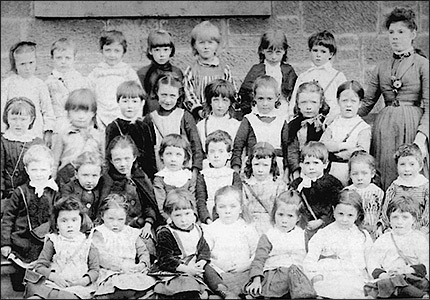| Article by Kate Coles |
||||||||||||||||||||||
|
||||||||||||||||||||||
|
||||||||||||||||||||||
|
The log books for the school survive from 1863 and the admission registers from 1872. For the teachers of St. Mary's, it was a battle against all the odds to provide even the most basic education for the children of Burton Latimer. Children were allowed by law to commence school at the age of 3, but admissions took place at any age up to 8 years - a frequent comment in the log book being 'The child was admitted at seven/eight years old and does not know his/her letters'. Once admitted to school, a child would by no means attend regularly. Illness was a frequent cause of absence, but in the cramped conditions and poor sanitation, many diseases reached epidemic proportions, the most common being scarlet fever, scarlatina, measles and whooping cough, often causing the school to be closed down. There were many cases of children being excluded from school for ringworm and head lice. Almost invariably, families were large and the children were part and parcel of the struggle to maintain a reasonable standard of living, so school holidays were set by the agricultural seasons. The long summer holiday was taken during harvest - late August to middle/late September - in order to minimise the absence of the children who were needed for gleaning and taking dinner to the men working in the fields. In May, many children were absent 'cowslip picking' and, if there had been a high wind, the children were sent 'sticking' for firewood. Education came a poor second to the family's need to survive. The road to the school was poor and many children failed to attend in severe winter weather and indeed, in wet weather, at any time of the year. It would seem that many children did not possess suitable outer garments, since the only items to be hung on the pegs in the lobby were hats and caps. Then, of course, there were the traditions and outings which provided a greater attraction than school and, in some cases, a free meal. On 1st May, the children would go 'a-Maying' displaying garlands of flowers and the girls dressing up their dolls for pennies. The Baptist Sunday School Treat and the Church Sunday School Treat necessitated closure of the school for a whole day on each occasion. Grand weddings, funerals, the hounds meeting at the Hall, a 'wild beast show' passing through Isham -all drew the children from their lessons. When Barnum and Bailey's circus came to
A full attendance for the school in 1883 meant 140 children, each child paying a standard sum of money each week to attend. To teach them were the headmistress, who was the only certified teacher, one pupil teacher aged about 14, who periodically sat examinations towards certification, and one probationer aged about 13, sent from St. Mary's Mixed School, who would progress to pupil teacher if suitable. It was Mrs. Mary Ann Stalker, commencing her duties in 1872 as headmistress and remaining at the school for 35 years, who began to lay the foundations of a better education for the children. Naturally, much emphasis was placed on reading, writing and arithmetic and, as it was a
Mrs. Stalker's major contribution to the children's wider education was the introduction of lessons in Natural History, the Human Body, Geography and Objects. Some examples of her lessons are given below:
The School Inspector's report each January, whilst the children were in Mrs. Stalker's care, was always that 'the children are excellently taught'. Mrs. Stalker was married to the headmaster of St. Mary's
|
||||||||||||||||||||||
